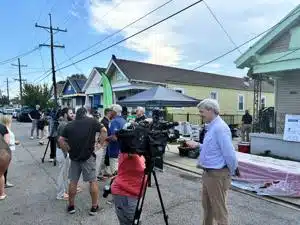(The Center Square) – A battle is brewing nationwide over whether recipients of SNAP benefits, also known as “food stamps,” should be allowed to purchase soda and candy with their government food assistance.
Critics of the new push to ban soda and candy purchases under SNAP say it unfairly targets lower income families, limits consumer choice and won’t result in better health outcomes.
Governors in four states are asking the federal government for waivers allowing them to prevent SNAP recipients from using their benefits to purchase what one governor calls “taxpayer-funded junk food.”
SNAP overall costs the federal government about $115 billion per year. A wide array of products are currently disallowed for SNAP users, from alcohol to tobacco products to pet food to vitamins.
Secretary Brooke Rollins, who oversees the U.S. Department of Agriculture, has publicly said she would approve the waivers.
Health and Human Services Secretary Robert F. Kennedy Jr. also said in a recent speech he welcomes the effort from state leaders.
The scope of the bans vary by state. In West Virginia, the ban would restrict soda purchases. In Idaho and Indiana, the limits apply to soda and candy.
Arkansas Gov. Sarah Huckabee-Sanders submitted a waiver to the Trump administration last week asking permission to enact the ban in her state blocking SNAP purchases of soda and candy, as The Center Square previously reported. Notably, Sanders’ waiver “will extend to confectionary products with flour…” which is a more broad definition of candy than in some other states.
Sanders’ waiver also requests SNAP recipients be allowed to purchase rotisserie chickens with their benefits, which are currently blocked under the “hot food” purchase ban at the federal level.
Sanders raised the issue with the Trump administration in December, sending a letter to U.S. Department of Health and Human Services Secretary Robert F. Kennedy Jr. and U.S. Department of Agriculture Secretary Brooke Rollins before they were confirmed by the Senate.
“As Secretaries, I ask that you work collaboratively across the Administration to prohibit the sale of junk food in SNAP and end taxpayer-funded junk food,” the letter said. “I also wish to notify you of my intent to pursue a SNAP Waiver from the U.S. Department of Agriculture’s Food and Nutrition Service that would support fresh fruits, vegetables, eggs, and protein and prohibit using SNAP for junk food.”
Lower-income Americans who receive the benefits could still purchase those snacks and beverages, just with their own cash, not the government assistance.
“In fact, soda, unhealthy snacks, candy, and dessert account for nearly 23 percent, or $25 billion, of all SNAP purchases,” Sanders said. “Given the relationship between junk food and poor health, our federal food assistance policies are fueling obesity, diabetes, heart disease, hypertension, and a wide range of chronic health conditions across America.”
Critics of the new push to ban soda purchases under SNAP say it unfairly targets lower income families and limits consumer choice.
States efforts vary in their approach. Efforts to ban soda and candy are simpler, but language from Huckabee-Sanders and others about “unhealthy snacks” would be much more complicated to regulate.
Determining which foods are “healthy” or not could be tricky. Does trail mix count as candy if it includes some? Does gum count as candy? Generally, definitions are required to make a distinction between sodas and whether certain “juices” are acceptable.
“This policy approach is misguided and not needed when it comes to chocolate and candy,” Chris Gindlesperger, senior vice president of Public Affairs and Communications at the the National Confectioners Association, said in a statement. “SNAP participants and non-SNAP participants alike understand that chocolate and candy are treats – not meal replacements. In fact, candy purchasing patterns are basically equivalent between SNAP and non-SNAP families – with only about 2% of SNAP purchases being candy. Consumers have a unique mindset when they enjoy chocolate and candy that is not present when interacting with other foods – whether or not they are using SNAP benefits for food purchases.”
Besides the four states whose governors have said they are moving forward with some version of restrictions on SNAP purchases, other states have seen similar efforts.
In some cases, only soda is in the crosshairs.
In Ohio, a measure making its way through the legislature would result in blocking SNAP purchases of sugary drinks, efforts the beverage industry says is unfair and won’t improve individuals’ health.
“Make no mistake, this waiver won’t make an ounce of difference on health,” the trade organization American Beverage said. “Obesity has skyrocketed in the last two decades while beverage calories per serving have dropped by 42% – thanks to our industry’s efforts to empower Americans with more choice and information. In fact, 60% of beverages Americans buy today have zero sugar due to our innovation.”
In Michigan, State Rep. Brad Paquette, R-Niles, introduced a bill to prevent SNAP benefits from being used for soda. State leaders are facing opposition from critics as they get the initiative approved at the state level, but so far the Trump administration has said it is happy to approve the waivers when they are submitted.
“Michigan taxpayers should not be required to fund poor food consumption,” Paquette said. “This legislation is in no way calling for low-income individuals to be stripped of the assistance they currently receive to feed themselves and their families, but we have to recognize that this assistance is a privilege and comes at the expense of taxpaying workers.
“We should ensure that SNAP beneficiaries are not using this program in a way that is both exorbitant and palpably harmful to themselves,” Paquette added.
















































